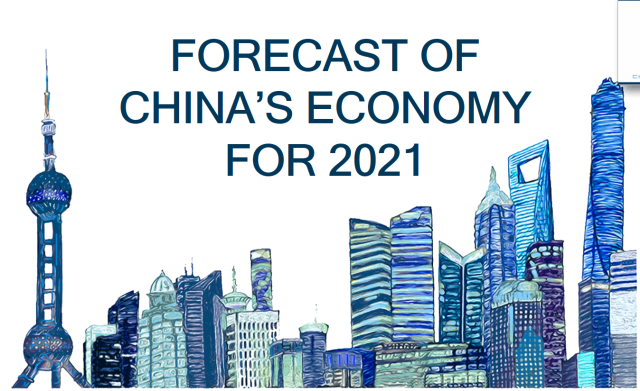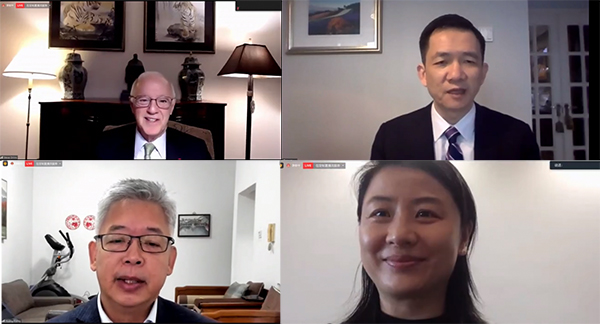
The raging COVID-19 pandemic has stricken a devastating blow to the global economy and posed new challenges to the exchanges between Chinese and US scholars. The China–US Economic Track II Dialogue serves as an important non-governmental exchange platform for Chinese and American scholars. Every January, Chinese experts hold “Forecast of China's Economy” forum at the New York Stock Exchange (NYSE), a move to enable more American investors, academic and business circles, the media and the public to have a better understanding of China’s economic development concepts and reform direction.
Through painstaking efforts in controlling the pandemic, China is the only economy in the world to show positive growth in 2020, and now China is narrowing the gap with US in total economic volume. In 2021, when the COVID-19 pandemic and the international economic landscape continue to be uncertain, the Chinese economy will attract more attention from American media, entrepreneurs and investors.

Against such a backdrop, the National School of Development (NSD) at the Peking University (PKU) and the National Committee on United States-China Relations held the “Forecast of China's Economy for 2021” forum via video link on the morning of February 3 (Beijing time). The guest speakers in attendance included Prof. Yao Yang, PKU Boya Chair Professor, Dean of the NSD, Executive Dean of Institute of South-South Cooperation and Development, Director of China Centre for Economic Research, and Cheung-Kong Scholar of the Ministry of Education, Prof. Huang Yiping, Deputy Dean of the NSD, Sinar Mas Chair Professor of Economics, and Director of the Institute of Digital Finance of PKU, Dr. Hu Yifan, Regional Chief Investment Officer & Chief China Economist UBS Global Wealth Management. The event was chaired by Steve Orlins, President of the National Committee on United States-China Relations. Hundreds of attendees from economics, business and press circles joint the event via video link and interacted with the guest speakers.

Dr. Hu Yifan first shared her views on five years of China economic forecasts. Chinese government is determined to reach high-income status and raises the prospect of doubling China’s GDP by 2035, which would imply an annual average growth rate of 4.7% over that period. Meanwhile, China strives to enter an era of high-quality development.
Hu held that in 2021 the Chinese economy is expected to maintain a strong recovery momentum and China’s economic growth can reach as high as 9%, which will further drive the global economic recovery.
Recently, some raised concerns in the credit market that the People’s Bank of China (PBC) may tighten liquidity. But Hu didn’t think so. According to her estimates, PBC, the central bank of China, will continue to maintain a flexible supply of liquidity this year, with an expected average annual growth rate reaching about 12%, and will continue to support consumption and investment growth. This is also conducive to shifting China’s focus toward “Urbanization 2.0” and building a powerful nation of science and technology.
When it comes to the potential risks in the Chinese economy, Hu said that China-US relations may still deteriorate. But for China, the most important thing is that China remains committed to its own cause no matter how the external environment changes, and constantly improves its overall national strength and international competitiveness. The signing of the RCEP Agreement in 2020 is a typical example of promoting multilateral cooperation.
Professor Yao Yang focused on the relevant contents of China’s “14th Five Year Plan (2021-2025)”.
He pointed out that people usually regard the Five-Year Plan as a guiding policy, but the “14th Five-Year Plan” is quite special. President Xi attaches great importance to the 14th Five-Year Plan. Xi not only has presided over a lot of research work, but also held a number of meetings and consulted experts and representatives from all walks of life. This means that, compared with the previous five-year plans, this plan not only covers important issues concerning more areas, but also is more enforceable and operable
Professor Yao held that the “14th Five-Year Plan” contains three highlights, which would play an important role in shaping China’s economy in the next 15 years:
First, China has entered the “Urbanization 2.0” era: China has been committed to promoting urbanization in the past 40 years, and in the next 15 years, this speed will be further accelerated, which means more than 200 million people will move from rural areas to urban areas. What is different from the past is that in the process of Urbanization 2.0, more people will gather in megacities. By 2035, China will have seven megacities, and the household registration system will be reformed accordingly.
Second, China has made a solid plan to tackle climate change. China aims to hit peak emissions before 2030 and for carbon neutrality by 2060. Currently, China’s economy still relies heavily on the fossil fuel, so it is not easy to achieve these two targets. To this end, the Chinese government is likely to introduce a series of policies and measures including carbon tax, carbon trading, and green finance, as well as intensifying its support for the development of new energy vehicles industry. As for China-US relations, properly dealing with climate change serves the common interests both sides. The US President Biden has made climate change one of his signature issues on different occasions. Therefore, China’s unprecedented emphasis placed on climate change in the “14th Five-Year Plan” will also contribute to the sound development of China-US relations.
Third, science and technologies must come through self-innovation and self-reliance, and we need to modernize industrial and supply chains. Chinese government has attracted unprecedented attention to this issue in the context of this trade war. In response, China has unveiled a “dual circulation” strategy and strives to achieve the objectives that the most key and core technologies must come from our own research and development. For example, China's chip self-sufficiency rate in the semiconductor industry is only about 30%, and China has set a goal of producing 70 % of the chips it uses by 2025. To this end, China will substantially increase its investment in key technologies to fire back at US technology sanctions.
Professor Huang Yiping shared his views on the development and reform trends of China’s financial system. He said that currently Chinese financial system is besieged by two prominent problems:
First, there is a lack financial support for the real economy: this is because China’s financial system has long depended too much on the banking system. In recent years, as China’s economy has entered a new stage of development, innovation has played an increasingly important role in economic growth. So, if we want to give full play to the role of financial system in supporting the real economy, we must step up support for innovation and for small and micro enterprises that are often neglected by the traditional bank-based financial system.
Second, financial risks have increased, and so does the pressure to avoid systemic financial risks. Among the world’s major emerging economies, China is the only country that has not experienced a systemic financial crisis in the past 40 years. The reasons are on the one hand attributed to effective supervision, and on the other hand, the rapid growth of the real economy also matters; the third reason lies in government guarantees. However, in recent years, we have observed the risks in many industries are on the rise. In the following fifteen years, China’s economic growth model will focus more on quality improvement and the pace of economic growth is changing. The government will not be able to provide unconditional guarantees to financial institutions forever. Systemic risks have increased sharply.
Against such backdrops, Professor Huang pointed out that the Chinese government has put forward a framework for financial reform, with three work priorities:
First, change the structure of financial intermediaries, increase the proportion of direct financing, and better support innovation;
Second, make the market play a decisive role in allocating financial resources, deepen reforms, and encourage the banking sector to constantly increase financial support to small and micro enterprises. The key point is to strengthen the use of financial big data and allow banks to establish market risk-based pricing mechanism;
Third, deepen the reform of the financial regulatory system.
Afterwards, many viewers asked questions to the guest speakers, and the interaction was very active. The online forum was also brought to a satisfactory conclusion.
About “Forecast of China's Economy” Forum
“Forecast of China's Economy” forum is part of the China–US Economic Track II Dialogue. The event is jointly held by the NSD at PKU and the Chinese team of the China–US Economic Track II Dialogue at the NYSE in January every year, with the aim of sharing China’s economic development logic and growth prospects globally. Through years of persistence, this forum has become an important window for the US and even the global business and investment communities as well as the public to observe and understand the Chinese economy. Due to the outbreak of COVID-19, this year’s forum was moved online.
About the China–US Economic Track II Dialogue
The China–US Economic Track II Dialogue is jointly held by the NSD at PKU (China Center for Economic Research) and the National Committee on United States–China Relations. The event was launched in January 2010 and is held twice annually, alternately in New York and Beijing. Due to the pandemic, it has been moved online since 2020. During the event, Chinese and American scholars, business leaders and other relevant parties will exchange their in-depth views on medium- and long-term issues such as China-US financial and trade relationship and the impacts on the global economic landscape, in an effort to help the academic circles and business communities of the two countries increase mutual understanding and trust. The results of the dialogue will be reported to relevant government departments of the two countries for decision-making reference.
Author: Zhang Shundong
Editor: Wang Xianqing and Bai Yao